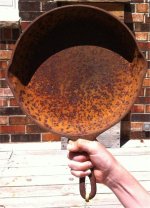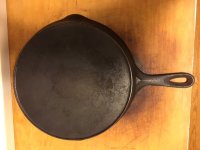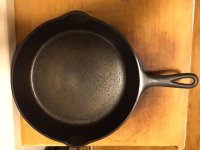I went to the OKC Land Run Antiques Fair this weekend. Not much in the way of Cast Iron.
There was however one piece that at first glance caught my eye. It was a #14 Griswold LBL skillet. It was hanging on a hook, and it looked nice at first glance.
I lifted it off the hook and the vendor had apparently spend quite a bit of time on the cooking surface with a stainless steel wire brush. The inside literally looked like the outside surface of "The Spirit of St. Louis". He must have put his whole body weight onto the drill, and sat there with it spinning in one spot for 10 minutes, then moved it slightly and started on another spot.
I simply commented "Nice piece, shame about the cooking surface" and he came unglued about how this was the industry standard way of cleaning a piece, and that he had cleaned and sold over 2,000 pieces.
I just shook my head and walked away, just as another person picked up the skillet, and said, "This is a huge Griswold, too bad they ruined it."
There was however one piece that at first glance caught my eye. It was a #14 Griswold LBL skillet. It was hanging on a hook, and it looked nice at first glance.
I lifted it off the hook and the vendor had apparently spend quite a bit of time on the cooking surface with a stainless steel wire brush. The inside literally looked like the outside surface of "The Spirit of St. Louis". He must have put his whole body weight onto the drill, and sat there with it spinning in one spot for 10 minutes, then moved it slightly and started on another spot.
I simply commented "Nice piece, shame about the cooking surface" and he came unglued about how this was the industry standard way of cleaning a piece, and that he had cleaned and sold over 2,000 pieces.
I just shook my head and walked away, just as another person picked up the skillet, and said, "This is a huge Griswold, too bad they ruined it."



